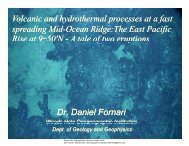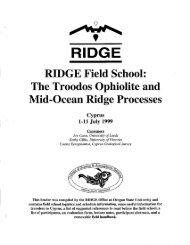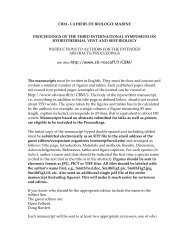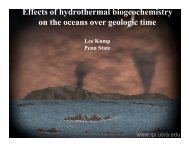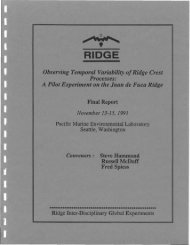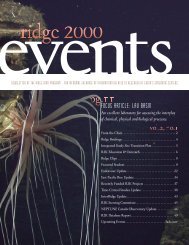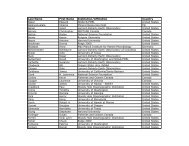Create successful ePaper yourself
Turn your PDF publications into a flip-book with our unique Google optimized e-Paper software.
Strategy<br />
Biological studies will emphasize four distinct scales of<br />
observation, sampling, and experimentation: (1) point scale of<br />
individual vents, (2) localized scale of vent fields,<br />
(3) regional scale of thousands of kilometers, and (4) global<br />
scale comparing regions.<br />
Required Techniques<br />
To achieve the listed objectives, the development and<br />
improvement of the following techniques are among the<br />
prerequisites:<br />
.!D. situ: (1) Instrumentation for chemical analyses of fluids<br />
on both instantaneous and long-term scales. (2) Instrumentation<br />
for measurement of microbial activity. (3) Measurements of<br />
animal growth rates and of soft and hard-part deterioration.<br />
(4) Organism manipulations for habitat alteration and colonization<br />
experiments. (5) A vehicle (remote or manned) available<br />
for, and capable of. repeated and non-disruptive visits to the<br />
same area. (6) Large- and small-scale photographic mapping.<br />
Laboratory: (1) Probes of the genetic make-up of organisms<br />
(ribosomal ribonucleic acid sequencing, isoenzyme assays,<br />
mitochondrial DNA comparisons, and DNA hybridization).<br />
(2) Equipment for maintenance of animals under simulated vent<br />
conditions. (3) Equipment for measurements of metabolism of<br />
microbes and animals under simulated vent conditions. 4. Image<br />
processing applied to deep-ocean photographs.<br />
Long-term: (1) Long-term bottom stations for continuous<br />
observations of specific sites. (2) Mechanisms for detecting<br />
biological markers in hydrothermal plumes. (3) Mechanisms for<br />
detecting subsurface life.<br />
Summary<br />
The chemosynthetically driven ecosystems of ridge crests can<br />
only be studied effectively if the physiologies, biochemistries,<br />
distributions, ecologies, and evolutionary histories of the<br />
microbial and animal species are linked to geochemical and<br />
geophysical processes. Basic understanding of the organismal<br />
adaptions enabling the tolerance and the exploitation of the<br />
vent waters, and comprehension of the way temporal and spatial<br />
variability in vent flow affect bacterial and animal life are<br />
the chief goals of the vent biology program. These goals can<br />
only be realized through complementary and collaborative programs<br />
in physical oceanography, geochemistry, and geophysics.<br />
Conversely, the success of these other, non-biological programs<br />
necessitates inputs from the biological studies, such as<br />
51






